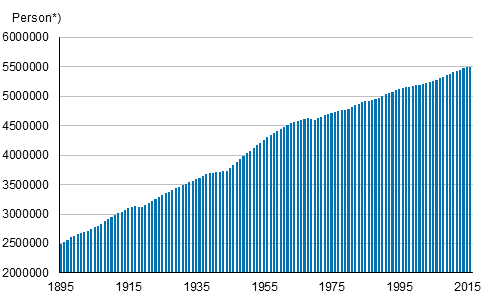Published: 25 October 2016
Finland's population in September for the first time closer to six than five million
According to Statistics Finland's preliminary data, Finland's population at the end of September 2016 was for the first time closer to six than five million. The population at the end of September was 5,501,043. The population went over the limit of five million in January 1991. Prior to this, the limit of one million was passed in 1950. Before surpassing the limit of 4.5 million in 1962, population growth was in a few decades clearly faster than in the past decades. The limit of three million was broken in 1912.
Population in Finland 1985–2016

*) Preliminary figure in 2016
Our country's population grew in January to September by 990 more persons than in the corresponding period in 2015. The biggest reason for the growth in population increase was the growing migration gain received from abroad. Migration gain for immigration was 3,420 higher than the year before. Natural population increase went down by 2,430 persons from one year earlier.
According to the preliminary statistics for September, 40,426 children were born from January to September period of 2016, which is the lowest figure during our independence. The number of births was 1,651 lower than in the corresponding period of 2015. The number of deaths was 39,728, which is 779 higher than one year earlier.
By the end of September, 24,604 persons moved to Finland from abroad and 11,567 persons abroad from Finland. The number of immigrants was 2,513 higher and the number of emigrants 907 lower than in the previous year's January to September. In all, 6,096 of the immigrants and 8,149 of the emigrants were Finnish citizens.
According to the preliminary data, the number of inter-municipal migrations totalled 218,110 from the beginning of the year to the end of September. Compared with the previous year, the decrease was 1,422 migrations according to the municipal division of 2016. The number of migrations between regions went down by 1,218 and the number of migrations inside regions by 204 from one year before.
According to preliminary data by region, the population grew in January to September 2016 in Uusimaa, Pirkanmaa, North Ostrobothnia, Central Finland, Åland, Central Ostrobothnia and Varsinais-Suomi.
The population grew in absolute numbers most in Uusimaa, where it went up by 14,557 persons. The next largest increase in population was seen in Pirkanmaa, 2,916 persons. Relative to the population, population increase was highest in Uusimaa, 8.9 per mil and in Ålanda, 6.3 per mil. Relative population growth was third largest in Pirkanmaa, 5.8 per mil. Population loss was highest in absolute numbers in the region of Etelä-Savo that lost 1,021 persons of its population. The population of Satakunta decreased by 953 persons, which was the second biggest population loss. In relative terms, the population loss in the early part of the year was biggest in Etelä-Savo, 6.8 per mil.
Most migration gain from intramunicipal and international net migration or total net migration was recorded for Uusimaa, 10,239 persons and Pirkanmaa, 2,560 persons. Most migration gain in relative terms from total net migration was attained by Uusimaa, 6.3 per mil and by Åland, 6.2 per mil.
In absolute numbers, migration loss from total net migration was biggest in the region of North Ostrobothnia, 442 persons. In the region of Kanta-Häme the loss was 431 persons. In relative terms, the biggest migration loss from total net migration was also found in Kanta-Häme, 2.5 per mil of the population.
During January to September 2016, migration between regions numbered 106,348. The highest gain from migration between regions was seen in Uusimaa, Pirkanmaa, Varsinais-Suomi, Central Finland, Pohjois-Savo and Åland. In absolute numbers, the highest gain from migration between regions was received by Uusimaa, 5,100 persons. The relative migration gain was highest in Pirkanmaa and Uusimaa, 3.1 per mil of the population.
In absolute numbers, migration loss in migration between regions was biggest in the region of North Ostrobothnia, 1,250 persons. Migration loss from migration between regions was biggest in relative terms in the region of Kanta-Häme and Ostrobothnia, 4.4 per mil of the population.
Source: Preliminary population statistics, Statistics Finland
Inquiries: Matti Saari 029 551 3401, Miina Keski-Petäjä 029 551 3240, info@stat.fi
Director in charge: Jari Tarkoma
Publication in pdf-format (281.8 kB)
- Tables
-
Tables in databases
Pick the data you need into tables, view the data as graphs, or download the data for your use.
Appendix tables
- Appendix table 1. Preliminary data on vital statistics by month of occurrence 2016 (25.10.2016)
- Appendix table 2. Vital statistics, final data 2010 - 2015 and preliminary data 2016* (25.10.2016)
- Appendix table 3. Comparison between preliminary vital statistics in 2016 and 2015 (25.10.2016)
- Appendix table 4. Preliminary vital statistics by region 2016 and change compared to 2015 final data, quarters 1 - 3 (25.10.2016)
- Appendix table 5. Preliminary data by region on immigrants and emigrants according to country of departure/destination 2016, quarters 1 - 3 (25.10.2016)
- Figures
-
- Appendix figure 1. Live births by quarter 1994 - 2015 and preliminary data 2016 (25.10.2016)
- Appendix figure 2. Deaths by quarter 1994 - 2015 and preliminary data 2016 (25.10.2016)
- Appendix figure 3. Intermunicipal migration by quarter 1994 - 2015 and preliminary data 2016 (25.10.2016)
- Appendix figure 4. Immigration by quarter 1994 - 2015 and preliminary data 2016 (25.10.2016)
- Appendix figure 5. Emigration by quarter 1994 - 2015 and preliminary data 2016 (25.10.2016)
Updated 25.10.2016
Official Statistics of Finland (OSF):
Preliminary population statistics [e-publication].
ISSN=2243-3627. September 2016. Helsinki: Statistics Finland [referred: 17.4.2025].
Access method: http://stat.fi/til/vamuu/2016/09/vamuu_2016_09_2016-10-25_tie_001_en.html

